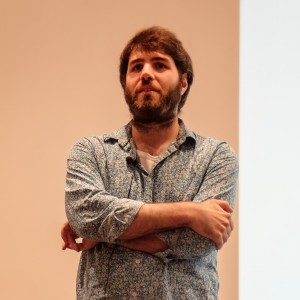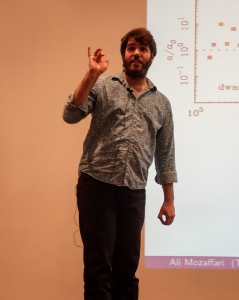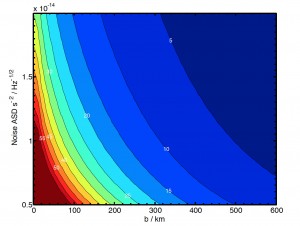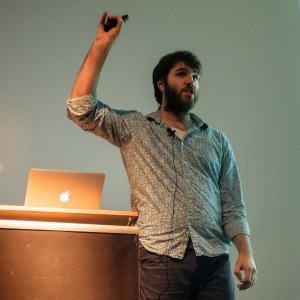September 15, 2014
Testing Gravity in the Solar System
Dr Ali Mozaffari
Report by: Andy Sawers
Dr Ali Mozaffari’s presentation on Testing Gravity in the Solar System was the opening event of the Flamsteed 2014-15 calendar – and it really raised the bar. But this being the Flamsteed Astronomy Society, many members leapt over that bar easily. In fact, Dr Mozaffari told us later how impressed he was by the quality of questions from the audience.
Some members vaulted the bar but grazed it, while for a few the bar was set so high they could walk under it wearing a top hat. But his talk had something for everyone.
The two cornerstones of modern cosmology are, he said, General Relativity and lambda cold dark matter model, or ΛCDM. It’s been known for centuries that the planets orbit the Sun in ellipses (with the Sun at one of the focal points), and almost all the planets behave themselves and obey that law.
Not so Mercury. Its orbit is different. The easiest way to describe it is to say that the ellipse of its orbit itself revolves around the Sun, a process known as precession which results in Mercury’s perihelion (the point at which it is closest to the Sun) moves significantly.
This makes it look as though Newton’s theory is wrong. For years, there was no obvious explanation for Mercury’s behaviour, though theories about unseen nearby planets abounded.
Einstein’s General Theory of Relativity (1915), however, gave mathematical predictions that almost exactly matched Mercury’s orbit.
Side question: why don’t we always just use Einstein’s theories? Short answer: Occam’s razor – which is a 14th century principle which says that the simpler hypothesis, the one with the fewest assumptions, should be selected over the more complicated one – and as Dr Mozaffari said, Newton’s theories were good enough to put men on the moon – so they can’t be all bad. Therefore, he said, we should only use Einstein’s theory if Newton’s theory isn’t going to be valid (for example, if dealing with black holes or the bending of light around stars and galaxies).
One problem where Newton and Einstein both fall down is the rotation of galaxies: the further you get from the centre of a galaxy the slower the stars should rotate around the centre of the galaxy (just as more distant planets move more slowly than those closer to the Sun). But it doesn’t work like that. In fact, they move at the same velocity. (More distant stars will still take a longer time to revolve around the centre of the galaxy but nowhere near as long as should be the case.)
- One solution to this problem is the idea of dark matter – non-luminous stuff that seems to ‘fit’ the data and sits well with theories about the formation of the universe. But the flaw with the theory of dark matter is that we haven’t found any yet (it’s dark!).
- Another approach is to change the theory of gravity, introducing a concept of Modified gravity such that gravity behaves one way on Earth and in the Solar System, but at the galactic scale, it behaves very, very differently.
Dark Matter is ‘a consensus idea’ amongst cosmologists, Dr Mozaffari said, while modified gravity is ‘a fringe area’. ‘But hopefully by the end of today’s talk you’ll get the idea that it’s not as wacky and way-out as you’d think.’
On the Dark Matter model, the calculations suggest that ‘ordinary matter’ – the stuff we already know about – is 4.9% of the universe. Dark Matter is 26.8% and Dark Energy – which is pushing the universe apart at an accelerating rate – is 68.3% of everything. So by this model, about 95% of the universe is stuff that we haven’t found yet.
The Modified Newtonian Dynamics (MOND) theory assumes that gravity acts differently on different scales – but the challenge is to test that. To do so, it’s necessary to find an environment where acceleration caused by gravitational forces is as low as possible eliminating gravitational ‘noise’ so as to be able to detect gravitational waves. The solution lies in conducting tests at a point between the Earth and the Sun where the gravitational force of each of them cancel each other out. It’s what Dr Mozaffari calls a ‘low acceleration target’. Getting an experimental probe into such a location – a gravitational ‘saddle point’ in the solar system – means that it will be able to detect gravitational ripples in space.
The European Space Agency’s LISA, the Laser Interferometer Space Antenna, is designed to look for gravitational waves – ripples in space-time. Previously an ESA/NASA joint venture, NASA pulled out because of budget considerations. ESA designed a cheaper version of the project.
A Pathfinder mission is expected to launch next year to test the concept of detecting gravity waves (prior to a full mission which could be 20 years away). As currently planned, the mission will put LISA into an elliptical halo orbit around the L1 Lagrange ‘saddle’ point, where the gravitational acceleration of the Sun and the Earth cancel each other out. (It’s a ‘saddle point’ in the sense that it is stable laterally – a knock left or right along the orbital path would result in the probe being pulled back into equilibrium – but unstable longitudinally – if it is knocked Earthward or Sunward then it will soon hurtle to its doom!)
From the European Space Agency website: LISA Pathfinder will test in flight the concept of low-frequency gravitational wave detection: it will put two test masses in a near-perfect gravitational free-fall, and control and measure their motion with unprecedented accuracy. To do this it will use inertial sensors, a laser metrology system, a drag-free control system and an ultra-precise micro-propulsion system.
LISA Pathfinder will orbit the L1 [Lagrange] point, located at 1.5 million kilometres away from the Earth in the direction of the Sun.
LISA Pathfinder will prove the techniques and equipment to detect the relative movement of two solid blocks that are freely floating in space to an accuracy of 10 picometres (1 picometre is equal to one millionth of a millionth of a metre).
We have an instrument sensitive enough to detect weird modified theory – and we have a weird modified theory that produces a big enough signal,’ Dr Mozaffari said.
The statistical methodology of calculating the number of standard deviations from the norm determines how good a prediction is. For the Higgs Boson team, Dr Mozaffari said, 5 standard deviations – 5 sigma – was the ‘gold standard’ that enabled the team to decide that they had, indeed, found the Higgs Boson. In the experiment that Mozaffari is proposing, the results will yield 28 sigma. ‘If we go and test these theories in space with this instrument, either we can say gravity is not as Newton suggested – or we can say this is all a load of nonsense.’
In fact, not only do they expect to achieve that degree of certainty but – because they can now get the probe to within about 10 kilometres of where it needs to be, it’s reckoned that they can get up to 50 sigma. That’s because such a precise orbit eliminates virtually all other gravitational ‘noise’ created by the two bodies the probe is parked between.
But the problem is that while LISA Pathfinder is currently planned to orbit the Sun-Earth saddle point – in an elliptical halo orbit 500,000km by 800,000km – Dr Mozaffari wants to convince the European Space Agency to send their probe right through the saddle point as a ‘mission extension’. ‘Their €10 billion instrument should spend another €1 billion to go and look for something that may or may not be there,’ he said. ‘But even 50 sigma doesn’t make European bureaucrats excited!
‘The issue now is as much about politics as it is about science,’ Dr Mozaffari said. ‘If you think about the people who work on dark matter as an idea, then it’s probably 75% to 90% of the astrophysics community. So this [modified theory] could put a lot of people out of business. That said, the people who have been looking for dark matter have been looking for it for decades and are becoming less and less convinced it’s what we imagined it is and therefore their experiments are a waste of time. But they won’t admit that!’
Further reading
Flamsteed debate on Dark Matter
Posted under: Flamsteed, Flamsteed Lecture, Meeting Report





You must be logged in to post a comment.